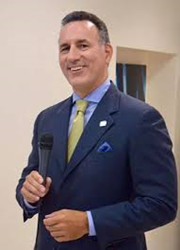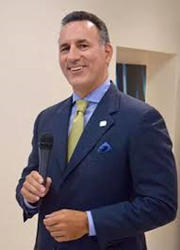
Dr. Alejandro Badia
As a nerve-compression disorder of the upper limbs, cubital tunnel syndrome is second only to carpal tunnel syndrome in frequency of occurrence.
MIAMI (PRWEB)
October 21, 2019
Sometimes, the elbow’s “funny bone” is just not that funny, especially when the nerve passing in it – the ulnar nerve — becomes irritated and inflamed due to chronic pressure and impingement – a condition called cubital tunnel syndrome, says noted hand and upper limb orthopedic surgeon Alejandro Badia, MD. He emphasizes that early diagnosis is essential.
In fact, experts contend recovery rates are nearly 90 percent when the condition is treated within a year of onset but drop to under 70 percent if a patient does not get help beyond a year. As a nerve-compression disorder of the upper limbs, cubital tunnel syndrome is second only to carpal tunnel syndrome in frequency of occurrence.
“The ulnar nerve lies directly behind the medial epicondyle – the elbow’s bony protrusion or “funny bone” — and is vulnerable to pressure and constriction. When the pressure on the nerve becomes great enough to disturb the way the nerve works, then numbness, tingling, and pain may develop along the inner portion of the elbow and in the forearm, hand, and fingers, specifically the ‘pinky’ and ring fingers,” explains Dr. Badia. He is founder and chief medical officer of the Florida-based Badia Hand to Shoulder Center and OrthoNOW®.
In severe cases, the condition can lead to weakness in the fingers, decreased hand grip and wasting of hand muscles.
“Unless properly diagnosed and treated, nerve compression disorders worsen over time and can cause nerve damage that becomes permanent or, in the best of circumstances, requires months of healing. When ignored, the hand loses fine dexterity and task such as typing, playing the piano or say, performing surgery, become near impossible,” Dr. Badia says.
The cubital tunnel is anatomically similar although less defined than the carpal tunnel in the wrist. It is a narrow passageway, composed of ligament, muscle and bone, behind the inside edge of the elbow. The ulnar nerve runs through the cubital tunnel on its way down the forearm and into the hand where the nerve controls the thumb and small hand muscles.
Symptoms of nerve compression within the cubital tunnel most frequently occur when the elbow is rested on hard surfaces for extended periods; is exposed to repetitive bending and straightening, particularly during work-related activities like painting; or kept in a bent position, as happens while driving, sleeping or holding a phone.
Other risks for developing the condition are injury to the elbow; presence of joint-inflammatory disorders like arthritis; obesity; and engagement in sports, particularly those involving throwing and overhead movements, says Dr. Badia.
The anatomy of the upper limb also may predispose some people to developing cubital tunnel syndrome. In those cases, the nerve may glide over the elbow’s bony bump as the elbow is bent and straightened. Eventually, the ongoing motion causes the nerve and connective tissue around it to become tender.
Conservative therapy is normally the first-line treatment for the syndrome, including application of cold compresses, over-the-counter anti-inflammatory medications, corticosteroid injections, prescribed exercises, changes in pattern of elbow use by avoiding activities that pressure the joint, wearing of a protective elbow pad — even splinting of the elbow at night to prevent over-bending it during sleep. However, should these approaches fail, surgical intervention may be required, Dr. Badia notes.
Dr. Badia is a recognized expert in endoscopic tunnel release – an innovative surgical procedure. The technique involves insertion of an endoscope through a tiny incision in the elbow, enabling a surgeon to visualize the operating field and relieve tension on the ulnar nerve minimally invasively.
“Endoscopic tunnel release is quicker and less painful than standard surgical approaches and typically requires minimal recovery time, and I am able to get folks back to most jobs within a week. In fact, I have had several throwing athletes return to the mound within 3 weeks due to the minimally invasive endoscopic approach,” Dr. Badia states. “Patients have experienced immediate relief of symptoms following the procedure. I have had several patients that noted relief in the recovery room when local anesthesia wore off!”
But, even newer treatments for cubital tunnel syndrome may be on the horizon. Two case reports published in the May 2019 issue of the journal Medicine indicate that pulsed radio frequency (PRF) stimulation applied to the ulna nerve at the medial epicondyle relieved the neuropathic pain of patients who had failed earlier therapy involving oral medication and steroid injections, however this will never replace the mechanical effect of actual nerve decompression in cases where the nerve has clear signs of compression
The best medicine, of course, is prevention, which is why Dr, Badia offers these tips to lower risk for cubital tunnel syndrome:
- Avoid resting the elbows hard surfaces for long periods of time.
- Warm up properly before engaging in strenuous exercise, physical work or sports.
- Take frequent breaks when performing activities requiring constant arm and elbow motion and avoid prolonged periods where the elbow is fully bent (flexed).
- Lose weight.
- Most importantly, if that “funny bone” is no laughing matter, contact an orthopedic specialist as soon as possible, Dr. Badia concludes.
Bio: Alejandro Badia, MD, FACS, internationally renowned hand and upper-limb surgeon and founder of Badia Hand to Shoulder Center and OrthoNOW®, a walk-in orthopedic care clinic. He is a member the American Society for Surgery of the Hand, American Association for Hand Surgery, and the American Academy of Orthopedic Surgeons. He is a specialist in treating all problems related to the hand and upper extremity including trauma, sports injury, joint reconstruction, nerve injuries and arthroscopic surgeries. http://www.OrthoNOWcare.com and http://www.drbadia.com
Share article on social media or email:

